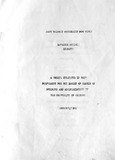| dc.description.abstract | The main objective of this thesis was to investigate the following:-
(1) The objectives that underlie cash balance manegenent decisions made by firms in Kenya;
(2) The degree to which firms in Kenya use decision rules that can be construed to be some form of decision medal;
(3) What variables and/or constraints go into cash balance decision making process;
and then;
(1) Formulate a hypothesis about cash balance management practices by Kenyan firms.
(2) Recommend a decision model
(3) Apply the recommended model to a Kenyan firm.
METHODOLOGY
A number of steps were set out in order to achieve the above mentioned objectives.
The first step was to consider a general introduction to the field of cash management as necessary. The introduction was aimed at highlighting the basic management problems. It also attempted to indicate the reasons why firms hold money balances, be it on deposit account and other short-term investments
or positive current accounts. Various factors that influence the demand for cash balances were also considered.
The second step was to lay a sound theoretical foundation. This was basically a review of existing literature on cash
V III
balance decision models. Basically, cash balance decision models were classified into two categories:- (0 Analytical models;
(2) Simulation models.
The weaknesses of analytical models as a tool for aiding cash balance decisions was considered. They work effectively if the assumptions made by these models hold true. This study of the strength and weaknesses of the various models later on
helped in the selection of a model for empirical application
«
in a Kenyan firm. The two steps formed the first section of the thesis which was labelled "Theoretical Framework".
Having developed a theoretical framework, the third step
was to empirically investigate the cash balance management practices by firms in Kenya. The method used in the empirical investigation was a questionnaire and limited personal interviews.
In total, thirty one. firms were involved in the exercise. The empirical investigation aided in developing a hypothesis on the cash balance management practices in Kenya. Eefore a model was selected for application to a Kenyan firm, basic foundations on T/hich such a model would function effectively was developed. There is no point introducing a model in an environment that is not yet prepared to receive it. This section
was therefore included as a warning that unless there exists efficient management policies at corporate level, the use of models in the finance department alone would be meaningless.
Even in the finance department, if a model intended to provide management with information on how efficiently the cash balances should be managed 1*3 need and on tho other band there are
IX
no such practices for the other functions cf the department Tfould he defeating the ultimate objective of having an efficient department.
OBSERVATIONS
Prom the outcome of the empirical survey, it was observed that:-
(1) The basic objective of cash balance decisions in Kenyan firms is geared at ensuring that at least enough balances
are held to meet transaction demand regardless of the costs of holding such cash balances;
(2) Pirns in Kenya do not use any decision rules that can be construed to constitute some form of a model;
(3) The major decision variable in cash ba1 an.ee decisions is working capital requirements;
(4) The majority of firms in Kenya use external financing to finance cash' balances;
(5) Cash balance is viewed as a means of facilitating transactions and not an investment item.
t
These observations forced the basis for my hypothesis.
The empirical test of the Gibbs buffer stock model brought out some useful results. It was basically intended to demonstrate the usefulness of employing a model to guide in decision making. However, the model tested seemed to show that ■che level of cash balance has a relationship with the level of activity- hut statistical tests were carried out and they showed that there was no significant relationship between the two. In his tests,
X
Gibbs came out vdth such a result. This therefore tends to suggest that other factors other than the level of activity influence the level of cash balances. This is subject to further
research since the te3t was carried out in two firms only, one in Britain and one in Kenya. Another observation was that the cash balance pattern of the Kenyan firm was very different from the British firm and this contributed to different required cash balances for the two firms. This tends to be wholly consistent with the general hypothesis that cash balance
requirements are a function of the unique cash flow pattern of the individual firm. Generalized decision rules are inappropriate.
A simple comparison of the results obtained from the application of the model with what would have been the results if seme of the analytical models was used was also made. It revealed that no useful results would have been obtained from an application of the model in terms of the determination of the amount of finance that should be allocated to cash balance to meet transactions for normal operations. They make generalized
decision rules with respect to the mixture of money resources that should be held by business organisations. | en_US |

